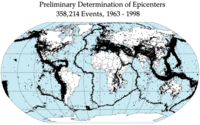
Photo from wikipedia
The Greenland landmass preserves ∼4 billion years of tectonic history, but much of the continent is inaccessible to geological study due to the extensive inland ice cap. We map out,… Click to show full abstract
The Greenland landmass preserves ∼4 billion years of tectonic history, but much of the continent is inaccessible to geological study due to the extensive inland ice cap. We map out, for the first time, the 3-D crustal structure of Greenland and the NW Atlantic ocean, using Rayleigh wave anisotropic group velocity tomography, in the period range 10–80 s, from regional earthquakes and the ongoing GLATIS/GLISN seismograph networks. 1-D inversion gives a pseudo-3-D model of shear wave velocity structure to depths of ∼100 km with a horizontal resolution of ∼200 km. Crustal thickness across mainland Greenland ranges from ∼25 km to over 50 km, and the velocity structure shows considerable heterogeneity. The large sedimentary basins on the continental shelf are clearly visible as low velocities in the upper ∼5–15 km. Within the upper continental basement, velocities are systematically lower in northern Greenland than in the south, and exhibit a broadly NW–SE trend. The thinning of the crust at the continental margins is also clearly imaged. Upper-mantle velocities show a clear distinction between typical fast cratonic lithosphere (Vs ≥4.6 km s−1) beneath Greenland and its NE margin and anomalously slow oceanic mantle (Vs ∼4.3–4.4 km s−1) beneath the NW Atlantic. We do not observe any sign of pervasive lithospheric modification across Greenland in the regions associated with the presumed Iceland hotspot track, though the average crustal velocity in this region is higher than that of areas to the north and south. Crustal anisotropy beneath Greenland is strong and complex, likely reflecting numerous episodes of tectonic deformation. Beneath the North Atlantic and Baffin Bay, the dominant anisotropy directions are perpendicular to the active and extinct spreading centres. Anisotropy in the subcontinental lithosphere is weaker than that of the crust, but still significant, consistent with cratonic lithosphere worldwide.
Journal Title: Geophysical Journal International
Year Published: 2018
Link to full text (if available)
Share on Social Media: Sign Up to like & get
recommendations!